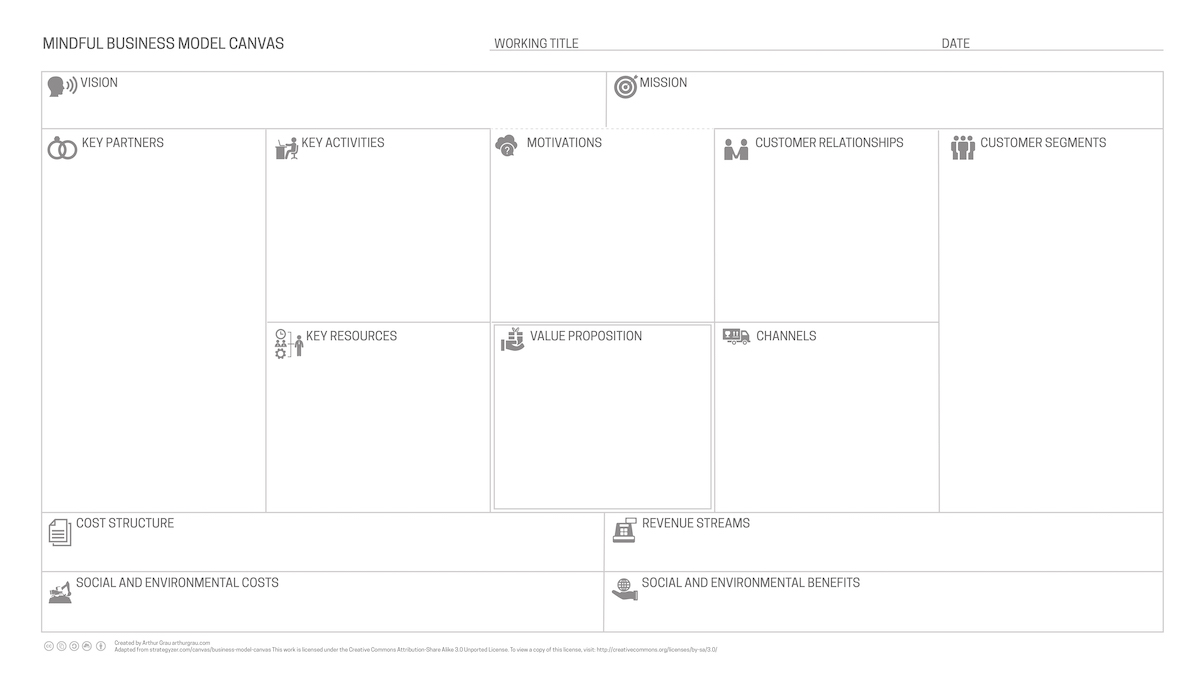Iterating on a startup innovation classic to allow for vision, mission, and systemic environmental concerns.
Facilitating entrepreneurs to build social benefit apps with Applications for Good and with user experience design at MIT, I adapted the now-classic Business Model Canvas. The tool and underlying theory create a simple stepped methodology for identifying and mapping business concerns. (1)
The Canvas and related tools have been used in management strategy and lean startup thinking for two decades. The creators have surely benefited many an entrepreneur or product manager. However, when the Canvas faces post-millennial income inequality, environmental concerns, and entrepreneurs’ growing social impact imperatives, it may not offer a complete model.
In this Mindful Business Model Canvas (pdf), I aim to accommodate both the impetus (purpose) and the fallout (externalities) that accompany businesses and their models. The goal is to share a more relevant canvas that may help owners and managers think about their businesses in new ways.
Why make a business in the first place?
Creators may request help defining their vision. They want to visualize their ideas to rally teams and grow their ideas into a model and, ultimately a business. While the creators of the Canvas go so far as to create a “value proposition” worksheet, little if any space or reflection is given to a creator’s pure vision of a future world. So many entrepreneurs and creators start with this vision, an ‘ideal’ that sparks their business ‘idea’. For this reason, why not include it right on the canvas as a potent reminder of the ‘why’ that really motivates the rest of the ‘how’ of the Canvas?
And what comes out the other end of our business?
Nobody and no business works in a vacuum. Every enterprise will generate “externalities” or byproducts. Every working environment will have its cultural, social, and environmental impacts. While we model a business, let’s start from scratch, mindfully co-creating the nature of those impacts.
Using the Mindful Business Model Canvas
The original Business Model Canvas is accessible and easy to use. To build on this design principle, the Mindful Business Model Canvas follows the original pattern and layout while adding layers for input and output complexities. Below are some pointers for those sections of the Canvas that diverge from the original. For all other sections, please see the original in the notes below.
- Vision
- What does the future state look like?
- This is not about how your business sees itself, it’s about what the world will be like with your gifts added to it.
- “We envision a world where…”, is a great place to start.
- Mission
- Here, we zero in on what you or your enterprise can do.
- This may come last as you work your way through the rest of the canvas.
- Motivations
- Remember here why, who, or what got you started on this track in the first place. Leave space to reference your prime motivator.
- Maybe you lost a loved one to a disease, and you’re working on creating preventions or cures.
- Maybe you love poetry, so you’re launching a poetry website and speaker series. Why are you motivated to do it?
- Value Proposition
- Here, you distill your vision, mission, and motivation into the primary value proposition you’re bringing to the market. Why would people want it just because you believe some business or service should exist?
- What problems are you solving for your customers?
- Who are you helping your customers to become?
- Mapping the traditional Canvas: partners, activities, resources, relationships, channels, segments, costs, and revenues. There are myriad resources from the Canvas creators and others to fill in these sections along traditional lines.
- Social and Environmental Costs
- Here’s where you start to look downstream.
- What happens to the neighborhood if you create a new goods delivery app?
- How will your business model impact the physical world?
- Social and Environmental Benefits
- Here’s where you can begin to map all those benefits you create in the world that are not measured by cash income.
- Perhaps your business model is a social enterprise. The original Canvas offered no way to capture your model’s benefits to consumers or the environment.
- Here is where you can begin to model and account for those activities that may have benefits other than making a profit.
Notes
(1) Barquet, Ana & Cunha, Vitor & Oliveira, Maicon & Rozenfeld, Henrique. (2011).
(2) Sustainable business model design
(3) The Case for a Socially Oriented Business Model Canvas: The Social Enterprise Model Canvas

